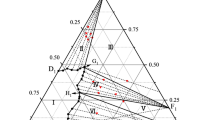Abstract
The solubility of maltitol in pure water and industrial syrup was measured in a temperature range from 10 to 90 °C. Maltitol is highly soluble in water, and this yields high viscosity values for the saturated aqueous solutions at different temperatures. In addition, solubility of maltitol in ethanol/water mixtures was followed at 30, 35, 45, and 55 °C. Results show that maltitol solubility is highly dependent on water content in the solvent mixture. Moreover, it increases monotonically with temperature. The logarithm of viscosity changes linearly against the mole fraction of maltitol in the aqueous solutions up to saturation. The saturated solutions showed a Newtonian behavior in a temperature range from 20 to 90 °C. Maltitol is also characterized in supersaturated solutions by a narrow metastable zone, which slightly increases as temperature is raised. The density of aqueous solutions of maltitol was measured as a function of molality up to saturation at 20 °C, and results show that density can be correlated with concentration according to a linear relation. The obtained results were used to explain maltitol crystallization, which exhibits a high nucleation rate and a slow growth leading to small size crystals.









Similar content being viewed by others
References
A. Schouten, J.A. Kanters, J. Kroon, P. Looten, P. Duflot and M. Mathlouthi, Carbohydr Res 322(3–4), 298 (1999).
F. Hutteau, M. Mathlouthi, M.O. Portmann and D. Kilcast, Food Chem 63(1), 9 (1998).
F. Ronda, M. Gómez, C.A. Blanco and P.A. Caballero, Food Chem 90(4), 549 (2005).
A. Maguire, J. Rugg-Gunn and G. Wright, J Dent 28(1), 51 (2000).
S. Ohno, M. Hirao and M. Kido, Carbohydr Res 108(2), 163 (1982).
G.A. Jeffrey and H.S. Kim, Carbohydr Res 14, 207 (1970).
M. Mathlouthi and J. Genotelle, Rheological properties of sucrose solutions and suspensions. In: Sucrose, Properties and Applications, edited by M. Mathlouthi and P. Reiser (Blackie A & P, Glasgow 1995), p. 126.
A. Van Hook, Kinetics of crystallization—growth of crystals. In: Principles of Sugar Technology, Vol II, edited by P. Honig (Elsevier, Amsterdam 1959).
C.H. Schilling, M. Sikora, P. Tomasik, C. Li and V. Garcia, J Eur Ceram Soc 22(6), 917 (2002).
H. Schiweck, M. Munir, K.M. Rapp, B. Schneider and M. Vogel, New Developments in the use of Sucrose as an industrial bulk chemical. In: Carbohydrates as Organic Raw Materials, edited by F.W. Lichtenthaler (VCH, Weinheim 1991), pp. 58–68.
F. Capet, S. Comini, G. Odou, P. Looten and M. Descamps, Carbohydr Res 339(6), 1225 (2004).
G. L. Bockstanz, M. Buffa and C.T. Lira, J Chem Eng Data 34(4), 426 (1989).
J.W. Mullin, Crystallization (Butterworths, London, UK 1972).
G.A. Jeffrey, Cooperativity, patterns, graph set theory, liquid crystals. In: An Introduction to Hydrogen Bonding, (Oxford University Press, New York, Oxford 1997), pp. 105–107.
M. Mathlouthi, Carbohydr Res 91(2), 113 (1981).
M. Mathlouthi, A.L. Cholli and J.L. Koenig, Carbohydr Res 147(1), 1 (1986).
G. Vaccari and G. Mantovani, Sucrose crystallization. In: Sucrose, Properties and Applications, edited by M. Mathlouthi and P. Reiser (Blackie A & P, Glasgow 1995), p. 33.
M. Mathlouthi and J. Genotelle, Carbohydr Polym 37(3), 335 (1998).
K. Wagnerowski, Gaz Cukrow 84(11), 241–246, 256 (1976).
Y. Zhu, D. Youssef, C. Porte, A. Rannou, M.P. Delplancke-Ogletree and B.L.M. Lung-Somarriba, J Cryst Growth 257(3–4), 370 (2003).
S.A. Parke, G.G. Birch, M.O. Portmann and D. Kilcast, Food Chem 67(3), 247 (1999).
A. Gharsallaoui, B. Rogé, J. Génotelle and M. Mathlouthi, Food Chem (2007), in press.
N. Lebrun and J.C. van Miltenburg, J Alloys Comp 320, 320 (2001).
M. Hirao, H. Hijia and T. Miyaka, Anhydrous crystals of maltitol and the whole crystalline hydrogenated starch hydrolysate mixture solid containing the crystals, and process for the production and uses thereof. US Patent 4408041 (1983).
A. Van Hook, Sugar Technol Rev 8, 41 (1981).
M. Siniti, S. Jabrane and J.M. Létoffé, Thermochim Acta 325, 171 (1999).
G. Vaccari, Continuous cooling crystallization versus evaporation crystallization. In: Proceedings of the 3rd International Symposium organized by Association Andrew van Hook (AvH), 1996, Reims, France, p. 51.
Acknowledgements
The authors gratefully acknowledge the technical and financial support of Roquette-frères S.A and especially the important scientific contribution of Pierrick Duflot during the research of this subject.
Author information
Authors and Affiliations
Corresponding author
Rights and permissions
About this article
Cite this article
Gharsallaoui, A., Rogé, B. & Mathlouthi, M. Solid–Liquid Equilibrium of Maltitol Aqueous Solutions—Implications on the Crystallization Behavior and Process. Food Biophysics 3, 16–24 (2008). https://doi.org/10.1007/s11483-007-9044-5
Received:
Accepted:
Published:
Issue Date:
DOI: https://doi.org/10.1007/s11483-007-9044-5




